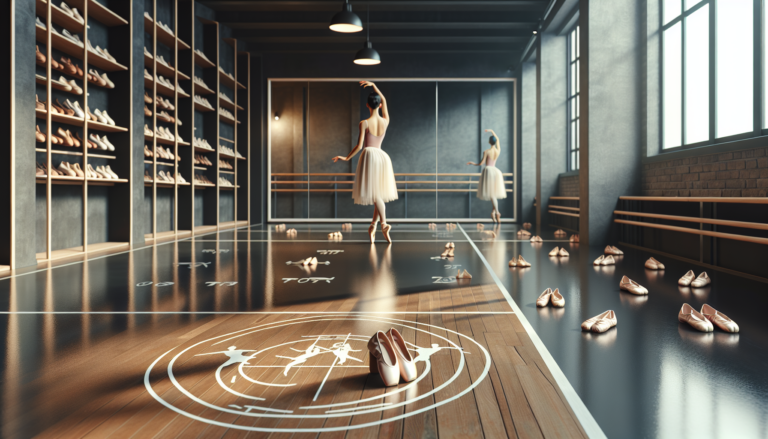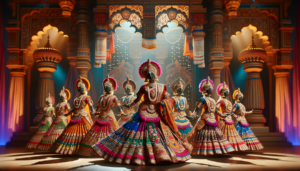Introduction to Dance Turns
Dance turns are an essential element of many dance styles, adding grace, fluidity, and excitement to performances. Mastering various types of turns is crucial for dancers of all levels, from beginners to professionals. Turns enhance choreography, showcase technical skill, and add visual interest to routines.
What Are Dance Turns?
Dance turns are rotating movements where the dancer spins on one or both feet. They can be performed in place or traveling across the floor. Turns require control, balance, and precise technique to execute properly. There are many different types of turns, each with its own unique mechanics and style.
Importance of Mastering Dance Turns
The ability to perform turns well is a mark of a skilled dancer. Clean, controlled turns convey a dancer’s strength, grace, and technical proficiency. Turns are frequently used in choreography across dance genres, from ballet to jazz to contemporary. Mastering a variety of turns gives dancers greater versatility and helps them adapt to different performance demands.
Basic Dance Turns for Beginners
When learning to turn, it’s important to start with the fundamentals. Beginners should focus on building a strong foundation before progressing to more complex turns. Here are some basic turns that are ideal for novice dancers:
Single Pirouette
The pirouette is a classic turn seen in many styles of dance, especially ballet. Single pirouettes involve completing one full rotation on one leg, with the other leg bent and the foot placed against the knee of the supporting leg. To perform a pirouette:
- Begin in fourth position with your weight on your back leg.
- Plié and then relevé onto the ball of your back foot, with your front foot pointed.
- Lift your front leg to passé position and spot your head.
- Complete one full rotation and lower your front foot to the ground in fourth position.
Pivot Turn
Pivot turns are simple traveling turns that are commonly used in jazz and theater dance. To do a pivot turn:
- Step forward onto one foot, with your feet shoulder-width apart.
- Bend your knees slightly and rotate your back foot to turn your body 180 degrees.
- Shift your weight onto your back foot as you lift your front foot.
- Lower your front foot to complete the turn, now facing the opposite direction.
Full Turn
Full turns involve a 360-degree rotation on one supporting leg. To perform a full turn:
- Stand on one leg with the other leg extended.
- Bring your arms overhead to help you balance and spot.
- Plié on your supporting leg and push off into the turn.
- Rotate your body a full 360 degrees, keeping your supporting leg straight.
- Lower your extended leg to finish in the same position you started.
Intermediate Dance Turns
As dancers develop their skills, they can begin to incorporate more advanced turns into their repertoire. Intermediate turns often involve multiple rotations, changes of direction, or unconventional leg and arm positions. Some intermediate-level turns include:
Double Pirouette
As its name suggests, a double pirouette is a pirouette with two complete rotations. Start by mastering clean single pirouettes, then gradually build up to doubles. Maintaining a strong passé position, keeping your core engaged, and spotting are key to successful double pirouettes.
Piqué Turns
Piqué turns are traveling turns that move across the floor. The dancer steps directly onto relevé of the supporting leg and then rotates, finishing in arabesque or attitude position. Proper alignment and control are essential in piqué turns. A strong supporting leg and a lifted, lengthened spine help create the illusion of effortless motion.
Turns En Dedan and En Dehor
En dedan and en dehor refer to the direction of rotation in certain turns. En dedan turns move inward, toward the supporting leg, while en dehor turns rotate outward, away from the supporting side. Dancers must be able to perform clean turns in both directions to have a well-rounded skill set. Fouetté and à la seconde turns can be done either en dedan or en dehor.
Advanced Dance Turns
Advanced turns require exceptional strength, control, and artistry. These turns often incorporate multiple technical elements and demand a high degree of precision. Advanced dancers may perform turns at faster tempos, in unusual positions, or with added embellishments. Examples of advanced turns include:
Fouettés
Fouetté turns are a series of turns performed on one leg, with the working leg extending and whipping around to propel the rotation. Fouettés are most commonly seen in ballet, but are also used in jazz and contemporary choreography. A single fouetté turn involves a 360-degree rotation, but fouettés are often done in sequence, with multiple rotations in a row.
À La Seconde Turns
In an à la seconde turn, the dancer rotates with the working leg extended directly to the side, parallel to the floor. These turns showcase both strength and flexibility, as the dancer must maintain a high extension throughout the rotation. À la seconde turns can be performed either in place or traveling, as in piqué turns.
Jazz Pirouette Forced Arch
A jazz pirouette forced arch is a pirouette with an exaggerated arch or contraction in the upper back. The dancer begins in a wide second position, rotates on the balls of the feet, and leans the torso back with the arms extended overhead. This distinctive position creates a sense of fluidity and style that is characteristic of jazz dance. Dancers must maintain control and balance throughout the turn to execute it effectively.
Tips for Perfecting Your Dance Turns
No matter your skill level, there are several key elements to focus on when working to improve your turns. Consistent practice and attention to proper technique will help you master even the most challenging turns. Keep these tips in mind:
Maintaining Balance
Proper alignment is crucial for balance in turns. Keep your hips stacked over your supporting leg, and avoid letting your weight shift too far forward or back. Engage your core muscles to provide stability and control. Make sure your supporting foot is strong, with your weight centered over the ball of the foot.
Spotting Techniques
Spotting helps dancers maintain their balance and orientation during turns. To spot effectively:
- Fix your gaze on a single point straight ahead.
- As you begin to turn, keep your head facing forward while your body rotates under it.
- When your head can no longer comfortably remain forward, quickly whip it around and refocus on your initial spot point.
- Your head should be the last part of your body to turn and the first to arrive back at the front.
Strength and Flexibility
Turns demand both strength and flexibility. Dancers need sufficient leg and core strength to maintain proper alignment and generate power in rotation. Flexibility allows for greater range of motion and extension, enhancing the lines of the turn. Regularly practicing calf raises, relevés, leg lifts, and core-strengthening exercises will help improve your turns. Remember to always properly warm up your muscles before attempting challenging turns.
Popular Dance Turn Tutorials
Many dancers find it helpful to study tutorials to learn proper turn technique and get inspiration for incorporating turns in choreography. YouTube is a great resource, with a wide variety of dance channels offering high-quality turn tutorials. Some of the most popular include:
Dance Ministry TV
Dance Ministry TV offers a variety of dance tutorials, including a comprehensive “Dance Turns and Spins” video that breaks down many different turns. The video has over 226K views and covers everything from basic pivot turns to more advanced turns like the jazz pirouette forced arch.
Ti & Me TV
Ti & Me TV provides clear, easy-to-follow tutorials for turns commonly seen in jazz and contemporary dance. Instructor @ti-and-me offers detailed tips for mastering pirouettes, fouettés, and à la seconde turns, among others. The channel’s “Let’s Do That Again: How to Do Pirouettes, Fouettés, and À La Seconde Turns!” video has been viewed over 726K times.
dancedeja
dancedeja shares a fun, fast-paced tutorial called “100 Fun Dance Turns” that demonstrates unique variations on standard turns. With 82K views, the video is great for dancers looking to add some flair and variety to their turning arsenal. It features everything from simple full turns to stylized moves like the flex foot coupé turn and a turn based on skating movements.
Conclusion
As you can see, turns are a vital skill for dancers across the spectrum of styles and abilities. From basic pivot turns to complex fouetté combinations, a wide range of dance turns can add depth and interest to any performance.
Summary of Key Points
To summarize what we’ve covered:
- Turns are rotating movements performed on one or both feet, in place or traveling.
- Mastering turns is important for dancers to have versatility and strong technique.
- Beginners should start with fundamental turns like pirouettes and pivot turns.
- Intermediate and advanced turns involve multiple rotations, directional changes, and stylistic elements.
- Proper alignment, spotting, strength, and flexibility are essential for executing clean turns.
Encouragement for Practice
No one becomes a brilliant turner overnight – it takes dedication and many hours of practice to perfect these skills. But with patience and persistence, any dancer can learn to turn with ease and panache.
So get into the studio, put on your favorite practice music, and start turning! Work through the building blocks of technique, take the time to master each type of turn, and don’t be afraid to put your own artistic twist on these classic dance elements. Soon, you’ll be dazzling audiences with your strong, controlled, expressive turns. Happy dancing!






